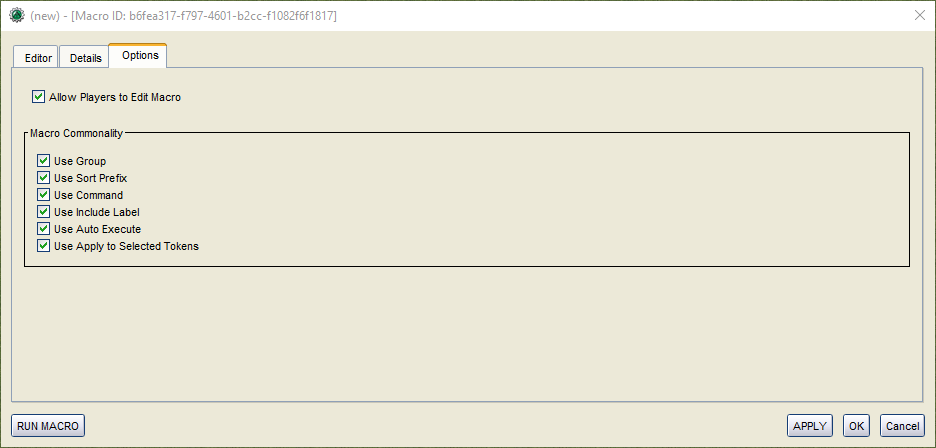Macro Commonality
This article is a stub, you can help the RPTools Wiki project by contributing content to expand this article.
This article needs: Needs more/fuller examples and cross-linking.

Macro Commonality options are found for every macro in the Macro Editor under the 'Options' tab. There checkboxes determines conditions for a macro to be listed under the special 'Common Macros' group in the Selection panel when multiple tokens are selected.
To be considered "common", macros **must** have the same name/label. If the names match, each macro is then compared to one another based on the checkboxes each macro has checked:
- Group
- Sort Prefix
- Command
- Include Label
- Auto Execute
- Apply to Selected Tokens
Each macro with a matching label will only be included in 'Common Macros' if each of its checked Macro Commonality options also matches all the others.
Visual settings (label colors, text size, and button size) don't affect macro commonality. The 'Common Macro' version of a macro button will be displayed with the last selected token's button style.
Examples of use
- Ignoring Command Differences: Consider multiple NPC tokens which are attacking simultaneously, but they may have slightly different commands in their 'Attack' macros. By deselecting the 'Use Command' Macro Commonality option on all of the Attack macros, they will still always appear under 'Common Macros' as a single macro when multiple NPC tokens are selected.
- Ignoring Sort Order & Group: Consider all player tokens have the same 'Long Rest' macro. The commands are identical, but one player has organized their macros into groups and used a 'Sort Prefix' on their version of the macro. By deselecting the 'Use Group' and 'Use Sort Prefix' Macro Commonality options on the all the 'Long Rest' macros, they will still appear under 'Common Macros' as a single macro when multiple player tokens are selected.
Note that if a token's version of a macro is different enough to exclude from 'Common Macros', such as a boss who shouldn't attack with their minions by accident in the first example, you could check 'Use Command' on that single macro and it will be excluded from 'Common Macros' (or, more reliably , simply rename the macro).